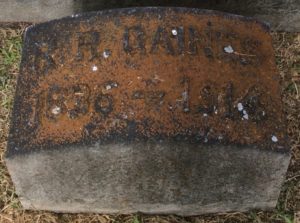Spring 2016
PSI ALUMNI HISTORIAN’S REPORT
Spring 2016
By T. Semmes Favrot
Below is a continuation of our Historian’s Report from the Spring 2016 Sighs of Psi, which is continued here due to space limitations in our newsletter. Click the pictures to view a larger image.
DKE Founder William Walter Horton
Buried in Faunsdale, Alabama
Part II
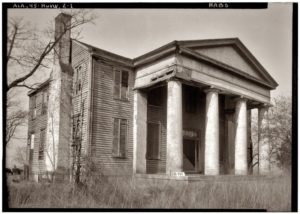
1934 photograph of the antebellum home of Rodah Horton, father of DKE Founder W. Walter Horton, near Huntsville, Ala. Construction of this home was completed around the time that Walter Horton co-founded DKE at Yale in 1844, and Founder Horton likely lived there for some time before moving to Marengo County. The home was demolished in 1949. Photo for the Historic American Buildings Survey.
DKE Founder William Walter Horton served in the Confederate army during the Civil War, though trying to nail down the correct details of his service has been complicated by some erroneous information and the fact that there are well over 100 named entries under “William Horton,” “W. Horton,” or some variation thereof listed in Confederate military service records. Horton does not seem to appear in military records until March 1863, so his activities during the early part of the war are unclear. His signature appears on a receipt dated March 28, 1863, for an officer’s sword belt (for which he paid $10) from Charleston Arsenal, South Carolina, on which he lists his rank as Captain. This seems to corroborate an entry in the 1890 DKE Catalogue that shows Horton as having served on the staff of General Johnson Hagood of South Carolina, which may have involved service in Robert E. Lee’s Army of Northern Virginia. Horton signed his name on this receipt and other documents as “W. Walter Horton,” indicating that he was known by his middle name.[1]
According to the book Yale’s Confederates: A Biographical Dictionary, Horton first served as Assistant Inspector General and then Captain under General John Tyler Morgan of Alabama, and then was appointed Adjutant of the 15th Texas Cavalry on May 22, 1863. We have found no service records corroborating any of this alleged service, and the latter information is probably erroneous, or his service with that Texas unit was very brief, because after being shown in Charleston in late March of ’63, his service record next shows him in his hometown of Union Town, Alabama on October 24, 1863, as Captain commanding Company L, 6th Alabama Cavalry.[2]
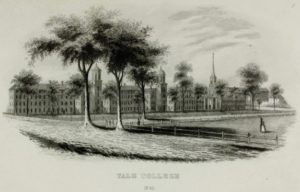
Yale College in 1845, the year after DKE was founded there. Image courtesy of the Phi Alpha British Colombia DKE Chapter.
Between January and November 1864, Horton appears to have bounced back and forth repeatedly between the 6th Alabama Cavalry and Livingston’s 8th Alabama Cavalry. This may not be as odd as it seems, as both of these units were organized under General James Holt Clanton, and served in his brigade. Horton may have seen combat with these units at Ten Islands, near Ragland, Alabama, as well as in the fighting in and around Dalton, Georgia[3]. Various documents signed by him show him located at different times at Clifton, Prairie Bluff, Selma, Gadsden, Blue Mountain (near Anniston), Talladega, and Oxford, Alabama.
Documents from June and July of 1864 indicate Horton had been promoted to Major, but by November he appears to have been reduced in rank back to Captain, for reasons that may be hinted at in a document from that time. On November 9, 1864, Horton wrote a letter tendering his resignation as Captain of Company B, 8th Alabama Cavalry. No reason for his request was given, but, in response to it, his commanding officer, General Clanton, wrote: “Approved- The applicant is addicted to drink and is otherwise inefficient.” This highly-accomplished man’s descent into problem drinking seems likely to have been fostered by the disruption and rigors of military life during wartime. It is presumed that Horton’s military career ended with the formal approval of his discharge on November 24, and that he spent the remainder of the war at his home in Marengo County.
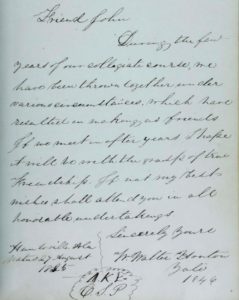
Note from DKE Founder William Walter Horton from the autograph book of another DKE Founder, John Butler Conyngham, Phi Yale 1846, courtesy of the Phi Alpha British Colombia DKE Chapter. The note reads: “Friend John, During the few years of our collegiate course, we have been thrown together under various circumstances, which have resulted in making us friends. If we meet in after years I hope it will be with the grasp of true friendship. If not my best wishes shall attend you in all honorable undertakings. Sincerely yours, W. Walter Horton, Yale 1846. Huntsville, Ala., [born] 27 August, 1825- D.K.E., C.S.P.” Horton subsequently fought for the Confederacy and Conygham for the Union in the Civil War. “C.S.P.” is an abbreviation for the secret motto of Scroll and Key, a Yale secret society to which Horton obviously also belonged.
Along with this article [see sidebar] is a transcription of an original handwritten and signed application for a Presidential pardon in connection with his Confederate service, written by Horton and addressed directly to U.S. President Andrew Johnson, dating probably from August 1865. The President had issued a proclamation on May 29, 1865, after the war ended, granting, with certain exceptions, amnesty to those who had aided the Confederate cause. One such exception was for those who owned property worth in excess of $20,000, and Horton felt this exception might apply to him, despite the loss and ruin occasioned by the war. This application was approved and endorsed by Alabama Provisional Governor Lewis Parsons and was apparently forwarded to President Johnson in Washington, but Horton was dead before there was any response to it.[4]
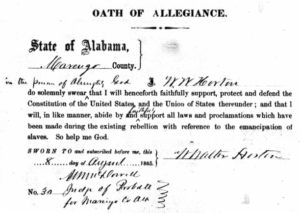
Oath of allegiance to the United States signed by DKE Founder and former Confederate soldier W. Walter Horton on August 8, 1865, after the end of the Civil War.
According to his Yale class secretary, Brother Horton died from “a virulent fever contracted in the malarious swamps”[5] soon after he applied for a pardon, on September 15, 1865, at the age of 40. This seems a rather ignominious end to one of the founders of our great fraternity, who excelled at Yale, served the Confederacy honorably, and, after the war, said he could “see no other way of restoring order and peace, except by yielding obedience to the authority of the United States,” and yet, was dead within a few short weeks later. He is buried in St. Michael’s Church Cemetery in Faunsdale, Alabama, at the intersection of County Road 59 & 54.[6] Anyone who has ever visited the famous Faunsdale Bar & Grill (in our humble opinion, the finest watering hole in Marengo County) has passed within about a mile of Brother Horton’s grave.
Walter Horton’s life experience seems somewhat metaphoric of the Old South itself, and of antebellum Alabama in particular. His family came from old Virginia, descendants of Revolutionary War soldiers who gave birth to the American nation. They immigrated to northern Alabama just after the end of the Indian wars, which had until then precluded large-scale settlement of the area. His father prospered as a member of the antebellum planter class, and, like many other members of that class, sent his son to be educated at Yale, an elite Northern institution. At Yale Horton thrived, co-founded a fraternity which has since spread across North America, won academic laurels, and gave his class commencement address at graduation. He returned south, started a family and had already achieved prosperity himself, when the Civil War interrupted his peaceful, pleasant life. He attained the rank of Major, but as the war wore on, he faced demotion, drinking problems, the disapproval of his commanding officer, and an early exit from the army. His early death just after the end of the war, in the prime of his life, mirrors the death of the Old South at the same time, at the end of the same war, after reaching the pinnacle of its antebellum prosperity. At least he was spared the dreadful experience of Reconstruction.
We have located a living collateral descendant of Brother Horton, and, lo and behold, he is a member of the Psi chapter. Brother John Otey Hutchinson, ’82, is a cousin of Brother Horton, through Horton’s mother, Lucy Ann Otey. Brother Hutchinson comprises one-third of the legendary DKE musical trio The Milton Edward Otey Band, along with his pledge brothers Lee Milton Hurley ’82 and James Edward “Jim” Harmon ’82. Brother Hurley is the Editor of Sighs of Psi and serves on the board of the Psi House Corporation. Brother Harmon is the father of two DKE active members: Psi Chapter President Hartson Harmon ’17 and Sam Harmon ’19, godson of the author.
On April 30, 2016, Brothers Hutchinson and Hurley, accompanied by bandmate Laine Poole, made a trek to Faunsdale to locate the grave of Founder Horton and pay their respects. The drive from Birmingham necessitated an obligatory thirst-quenching stop at Faunsdale Bar and Grill beforehand. Noticing a truck parked outside with DKE stickers on it, our intrepid grave-hunters went inside and encountered Brothers Tiff Lyons ’19 and Barry Fontentot ’19 (see photo). This chance encounter of DKE brethren seemed like a good omen as to the success of their quest, so after a cold drink and a group toast to Brother Horton, Hutchinson, Hurley, and Poole departed for the cemetery.
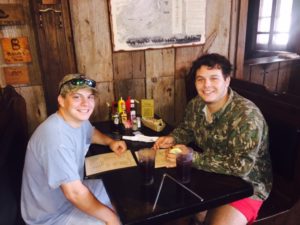
Brothers Tiff Lyons ’19 and Barry Fontentot ’19, unexpectedly encountered at Faunsdale Bar & Grill after a nearby turkey hunt on April 30, 2016. Photo courtesy of Lee Hurley.
Despite due and diligent effort and a thorough canvassing of the St. Michael’s cemetery, our trio of investigators was unable to locate the grave of Brother Horton, though graves of several of his relatives were found. We feel pretty certain that Brother Horton is indeed buried there, but it is not shocking that his 151 year-old headstone was not found. Old cemeteries are notoriously prone to vandalism and the ravages of time. It is entirely possible that Horton’s headstone toppled over at some point, and was soon covered with undergrowth, and is thus located just below the surface of the ground. On the other hand, perhaps there is something poignant about the headstone of one of the Founders of our “mystic” fraternity having seemingly vanished without a trace. We will continue to search for his grave, and when we find it, we hope that our pledges will be required to visit it annually, and, in the words of Bob Dylan, “see that his grave is kept clean.” We wouldn’t be shocked if visits to Faunsdale Bar & Grill followed.
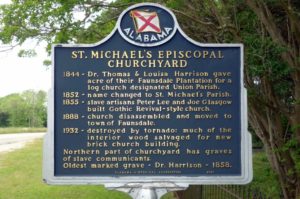
St. Michael’s Cemetery in Faunsdale, Alabama, where DKE Founder W. Walter Horton is buried. Photo courtesy of Lee Hurley.
We propose to make Brother Horton a posthumous honorary member of the Psi Chapter, without prejudice of course to his status as a member of Phi Yale and/or his status as a Founder of DKE International. We also feel that Brother Hutchinson’s status as a living blood relative of Founder Horton qualifies him as official DKE Royalty, which means that other DKEs are required to buy him drinks for the rest of his life. So, if you run into Brother Hutchinson, please do your duty and belly up to the nearest bar and buy him a cold one.
Application for Presidential Pardon
From DKE Founder William Walter Horton
To U. S. President Andrew Johnson
August 1865[1]
To His Excellency, Andrew Johnson, President of the United States.
The petition of William Walter Horton, a citizen of Marengo County, Alabama, respectfully shows that he is forty years of age, and a planter by profession, a vocation he has practiced all his life, except, during the war, which has just been brought to a close, he was a Captain in the Confederate service; in which capacity, he tried to perform his duty faithfully, and thus aid in the success of the Southern cause. That the contest is now decided, the South has failed and the United States succeeded in asserting its authority. He acquiesces, and has taken the oath required by your Excellency’s proclamation of the 29th May last, and annexes a — copy of said oath to this petition. He took this oath in good faith, and with an honest purpose to keep and observe it. He believes he discharged his duty in taking it, as he can see no other way of restoring order and peace, except by yielding obedience to the authority of the United States. [Written in different handwriting]: No proceedings have been instituted against him under the Confiscation Act.
Your petitioner now respectfully asks special pardon and amnesty. It would not be necessary for him to make this application except for the exception in the proclamation which applies to persons whose property would be estimated at [$]20 thousand. He is not affected by any of the other exceptions, nor does he know certainly, that his property would be estimated at 20 thousand dollars, but as it may be, he desires if [?] to file this his application, all of which is respectfully submitted.
Walter Horton
Answers of Wm. Walter Horton of Marengo Co. Alabama to interrogatories propounded to him by Lewis E. Parsons, Governor of the State of Alabama.
Answer to 1st. I am not under arrest & there are no proceedings pending against me.
Answer to 2nd. I did not order the taking of Fort Morgan or the Vernon Arsenal,[2] nor did I aid or advise the taking of either.
Answer to 3rd. I have never served on any vigilance committee during the war before which persons charged with disloyalty to the Confed. States have been tried.
Answer to 4th. No person has been shot or hung by my order for disloyalty to the Confed. States.
Answer to 5th. I have never shot or hung or aided in shooting or hanging anyone for supposed disloyalty to the Confed. States.
Answer to 6th. I have neither ordered or aided in hunting anyone with dogs for disloyalty to the Confed. States, or for supposed disloyalty.
Answer to 9th. I was in favor of the said Ordinance of secession.
Answer to 10th. I will be a peaceable citizen in the future.
Answer to 11th. No proceedings have been…[remainder of document missing].
[1] Other than minor spelling and punctuation changes made in the interest of clarity, this document appears exactly as written.
[2] Fort Morgan on Mobile Bay and the United States Arsenal at Mount Vernon, Alabama, were Federal military facilities seized by Alabama state troops just prior to Alabama’s secession from the Union in early January 1861. Federal authorities obviously took special interest in the individuals directly involved in those seizures.
Grave of Reuben Reid Gaines, Psi 1855, located in Austin, Texas
Speaking of graves of DKEs of bygone days, another such grave was located last summer in Austin, Texas. Four Psi brethren went to Austin last August to attend the DKE Leadership Summit. Brothers Jeffrey Kintz ’16 and Rony (“Dancing Bro”) Young ’16 were there representing the active chapter, John McNeil ’79 attended as a member of the board of DKE International, and Semmes Favrot ’82 spoke on recent research into the true story behind the iconic DKE poem, “Brothers in DKE.” The grave of Brother Reuben Reid Gaines, Psi 1855, was located in Oakwood Cemetery, right next door to the hotel where the entire DKE Summit delegation was staying. The Psi contingent visited the cemetery on August 7th and paid its respects to Brother Gaines (see photo). We’ll have more on Brother Gaines in a future Sighs of Psi.

From left, Brothers Rony (“Dancing Bro”) Young ’16, John McNeil ’79, Jeffrey Kintz ’16, and Semmes Favrot ’82 with the DKE flag at the grave of Psi Brother Rueben Reid Gaines 1855, in Austin, Texas, August 7, 2015.
DKE pin acquired- Brother Samuel Francis Hobbs,Psi 1908
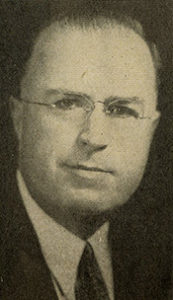
Brother Samuel Francis Hobbs 1908. Photo courtesy of Collection of the U. S. House of Representatives, http://bioguide.congress.gov.
For a long time now, we have been trying, without success, to acquire vintage DKE pins belonging to some of the distinguished past members of our chapter. That has changed with the recent acquisition of the DKE pin of Brother Samuel Francis Hobbs, Psi 1908. We will have more on Brother Hobbs and his pin in the next Sighs of Psi.
Update on Edwin Rogers and the Unknown Psi
Our research on identifying the Unknown Psi from the famous poem “Brothers in DKE” is ongoing, and has yielded much valuable additional information, though we have still not identified the subject DKE hero. We planned on reporting extensively on this in this article, but the above ramblings have precluded this for now. Stay tuned for more in the next Sighs of Psi.
Thanks first and foremost to Brother Sam Thomson, Zeta Zeta ’67, for alerting us to DKE Founder William Walter Horton, and his ties to Alabama. It was Brother Thomson’s naming of Horton’s mother, Lucy Ann Otey, which provided the clue that enabled us to link Brother Horton to Brother John Otey Hutchinson ’82. Thanks also to Brother Grant Burnyeat, Phi Alpha British Columbia ’65, Phi Alpha DKE Chapter, Michael Frost of Yale University, and John Hutchinson for additional information on Founder Horton. Finally, thanks to Brother Hutchinson, Brother Hurley, and Laine Poole for making the trek to Faunsdale in search of Founder Horton’s last resting place.
In the Bonds,
Semmes Favrot ’82
New Orleans, La.
Alumni Historian
[email protected]
[1] It is Horton’s signature that enabled us to finally distinguish our Founder’s record from those of similarly named men. The Application for a Presidential pardon [see sidebar] was indisputably signed by him, and we were then able to compare that signature to others and determine our man’s record.
[2] National Archives and Records Administration, via Fold3.com.
[3] Confederate Military History, Vol. VIII, Alabama, Extended Edition, Broadfoot Publishing Co., 1987, pg. 288-289, 274-275.
[4]Confederate Applications for Presidential Pardons, 1865-1867, Ancestry.com. The application is stamped “Received from Department of Justice, December 18, 1894,” which seems to indicate that the Application was indeed sent to Washington, D. C. prior to Horton’s death.
[5] Yale’s Confederates; Biographical Notices of Graduates of Yale College (1915).
[6] http://www.angelfire.com/indie/marengo/cems/faun.html
